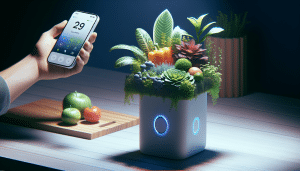Smart Home Upgrades You Never Knew You Needed
Henry King September 9, 2025
Explore smart home upgrades that can transform everyday living. This guide reveals how energy-efficient lighting, smart thermostats, automation, and eco-friendly gadgets elevate comfort while helping manage costs and improve security.
Understanding the Benefits of Smart Home Technology
Smart home technology has changed how households function, adding both convenience and energy efficiency. By connecting devices like thermostats, lights, and security cameras to a central system, many enjoy new levels of control and automation. For example, smart thermostats learn heating patterns and adjust settings to optimize comfort while potentially lowering energy bills. These technologies cater to both tech-savvy users and those seeking simple, hands-off solutions in daily routines.
The benefits extend beyond comfort. Smart devices often offer remote access, allowing users to monitor and manage their homes from mobile apps, even when traveling or running errands. Features such as adaptive lighting can enhance well-being, mimicking natural sunlight cycles to improve mood. Homeowners appreciate the flexibility of customizing routines and settings based on personal preferences, all while maintaining security and privacy according to their needs.
Another key advantage is long-term cost savings. Smart home automation can reduce wasted energy by ensuring systems like air conditioning only run when necessary. Integrating eco-friendly gear supports sustainable living. In this guide, discover the most impactful upgrades for household efficiency and security. Learn how incremental changes provide significant benefits, making life not just easier, but smarter.
Why Energy-Efficient Lighting is a Game Changer
Switching to energy-efficient lighting is one of the simplest smart home upgrades. LED bulbs, especially when connected to smart systems, use far less electricity than traditional incandescent bulbs. They also last much longer, reducing how frequently replacements are needed. Smart lighting offers the added benefit of remote control—owners can turn lights on or off using voice commands or smartphone apps, adding convenience and reducing energy consumption.
Some smart lighting systems include scheduling features. These allow lights to match personal routines, turning on at sunset or dimming automatically at bedtime. Having adaptable lighting can improve quality of life for people sensitive to harsh light or who prefer a gradual transition at the end of the day. Combining energy-efficient lighting with sensors that detect motion helps further decrease unnecessary usage and extends bulb lifespan.
The initial investment in energy-efficient lighting often pays off within a short time frame through lower utility bills. Many government agencies and energy organizations offer rebates or tips on making the smartest lighting choices for different room types (Source: https://www.energy.gov/energysaver/save-electricity-and-fuel/lighting-choices-save-you-money). Regularly upgrading lighting as part of an overall home improvement strategy keeps the environment comfortable and operating costs in check.
The Power of Smart Thermostats and Automation
Smart thermostats are among the most popular energy-saving home devices. They optimize heating and cooling schedules by learning household patterns, which eases the challenge of maintaining consistent comfort indoors. These devices adapt to weather, occupancy, and lifestyle changes automatically. Some even provide energy usage reports or adjust settings to save when no one is home, all without manual intervention.
Many users find value in integrating smart thermostats with other smart home systems like lighting or security. Synchronizing these devices enhances overall efficiency. For example, when a smart lock recognizes the house is empty, the thermostat can set itself to an energy-saving mode. This combination elevates both convenience and control, offering insights that help users make more informed decisions about their energy consumption.
Beyond energy management, smart thermostats support eco-friendly living. They often work with sustainable heating and cooling systems—such as heat pumps or solar-powered HVAC—further reducing carbon footprints (Source: https://www.epa.gov/heating-and-cooling/guide-energy-efficient-heating-cooling). Automated features mean less micromanagement and more time for life’s priorities, proving that upgrading to a smart thermostat is both a practical and responsible decision.
Integrating Security with Smart Home Systems
Security devices have evolved dramatically with smart technology. Homeowners now enjoy access to camera feeds, door sensors, and motion detectors in real time through connected devices. Smart security systems blend seamlessly with existing home setups, providing peace of mind and deterrents for potential break-ins. Many feature two-way audio communication, so visitors or deliveries can be managed remotely.
These systems often integrate with lighting and alarms, automating responses if suspicious activity is detected. If a system senses unexpected motion, it can trigger lights or send alerts directly to a personal device. That level of responsiveness supports fast decision-making in emergencies. Some solutions even include environmental monitoring, warning about fire, smoke, or water leaks, minimizing potential household risks and damages.
Costs for smart security systems vary based on features. Some elements, like cloud storage for video, require ongoing subscriptions, while others have no recurring fees. Choosing the right balance of devices and integrations depends on household needs and the value placed on security. Smart technology provides an adaptable, layered solution for protecting homes and personal privacy (Source: https://www.consumerreports.org/home-security-cameras/best-smart-home-security-systems-a7974144942/).
Eco-Friendly Smart Gadgets for Sustainable Living
Sustainability is a top priority for many upgrading their homes. Smart gadgets designed for sustainability help conserve water, electricity, and other resources. Some smart irrigation controllers tailor watering schedules for gardens or lawns by considering local weather data, preventing overwatering and promoting plant health. Leak detectors provide instant alerts when plumbing issues arise, helping prevent waste and reduce costly repairs.
Smart plugs and power strips further boost energy efficiency by controlling appliances and electronics remotely. These devices allow users to monitor which electronics draw standby power and easily switch them off when not needed. Over time, these incremental changes result in meaningful reductions in household energy demand. Many people are surprised at the difference these affordable gadgets make.
Solar-powered smart lights and chargers offer another eco-friendly solution, using renewable energy to power outdoor accents and critical devices during power outages. Manufacturers and environmental agencies offer guidance on the most effective and reliable products, making it easier to choose upgrades that align with household values and goals (Source: https://www.epa.gov/greenliving).
Choosing the Right Smart Home Upgrades for Any Budget
Budget concerns often shape decisions about which smart home upgrades to prioritize. Many entry-level smart devices are affordable and simple to install, making them accessible for most households. Smart bulbs, plugs, or a basic thermostat can introduce key benefits with minimal upfront commitment. This approach allows users to test features before expanding into a larger, connected ecosystem.
For households interested in more sophisticated upgrades, some companies offer bundled solutions that include installation and support, spreading costs over time. Manufacturers frequently release new product generations that may decrease prices for earlier models, making regular reviews of available products worthwhile. Diligent research and comparison help ensure that every investment delivers long-term value, not just novelty.
Nonprofit groups and public agencies sometimes provide advice about incentive programs, rebates, or grants aimed at supporting residential energy efficiency improvements (Source: https://www.energy.gov/savings/search). Staying informed about these opportunities can maximize savings and make smart home automation an attainable option for a broader range of people. Careful choices deliver sustainable results without compromising quality.
References
1. U.S. Department of Energy. (n.d.). Lighting Choices to Save You Money. Retrieved from https://www.energy.gov/energysaver/save-electricity-and-fuel/lighting-choices-save-you-money
2. U.S. Environmental Protection Agency. (n.d.). Guide to Energy Efficient Heating & Cooling. Retrieved from https://www.epa.gov/heating-and-cooling/guide-energy-efficient-heating-cooling
3. Consumer Reports. (2023). Best Smart Home Security Systems. Retrieved from https://www.consumerreports.org/home-security-cameras/best-smart-home-security-systems-a7974144942/
4. Environmental Protection Agency. (n.d.). Green Living. Retrieved from https://www.epa.gov/greenliving
5. U.S. Department of Energy. (n.d.). Energy Saver Rebates and Tax Credits. Retrieved from https://www.energy.gov/savings/search
6. CNET. (n.d.). How to Set Up a Smart Home: A Beginner’s Guide. Retrieved from https://www.cnet.com/home/smart-home/how-to-set-up-a-smart-home/







